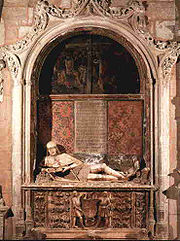
Arcosolium
Encyclopedia
 |
An arcosolium is an arched recess used as a place of entombment. The word is from Latin arcus, "arch", and solium, "sill" (literally: "place of state").
Early arcosolia were carved out of the living rock in catacombs. In the very earliest of these, the arched recess would be cut to ground level. Then, a low wall would be built in the front, leaving a trough (the cubiculum) into which the body would be placed. A flat stone slab would then over the chamber containing the body, thus sealing it. The stone slab would occasionally also serve as a memorial altar. In the later arcosolia, the arched recess would be carved out to about waist height. Then, the masons would cut downwards to make the chamber into which the corpse would then be placed. In effect, the trough was then a sarcophagus
Sarcophagus
A sarcophagus is a funeral receptacle for a corpse, most commonly carved or cut from stone. The word "sarcophagus" comes from the Greek σαρξ sarx meaning "flesh", and φαγειν phagein meaning "to eat", hence sarkophagus means "flesh-eating"; from the phrase lithos sarkophagos...
with living rock on five of its six faces. As before, a flat stone slab would then seal the chamber.
From the 13th century onwards, and continuing into the Renaissance
Renaissance
The Renaissance was a cultural movement that spanned roughly the 14th to the 17th century, beginning in Italy in the Late Middle Ages and later spreading to the rest of Europe. The term is also used more loosely to refer to the historical era, but since the changes of the Renaissance were not...
, arcosolia were built above ground, particularly in the walls of churches. In these post-Roman era recesses, which were built of brick and marble, the sarcophagii are usually separated from the arch. These tombs are highly ornamented in the styles of those periods; the Flamboyant Gothic
Flamboyant
Flamboyant is the name given to a florid style of late Gothic architecture in vogue in France from the 14th to the early 16th century, a version of which spread to Spain and Portugal during the 15th century; the equivalent stylistic period in English architecture is called the Decorated Style, and...
, Plateresque
Plateresque
Plateresque, meaning "in the manner of a silversmith" , was an artistic movement, especially architectural, traditionally held to be exclusive to Spain and its territories, which appeared between the late Gothic and early Renaissance in the late 15th century, and spread over the next two centuries...
, and High Renaissance
High Renaissance
The expression High Renaissance, in art history, is a periodizing convention used to denote the apogee of the visual arts in the Italian Renaissance...
styles are all represented.

